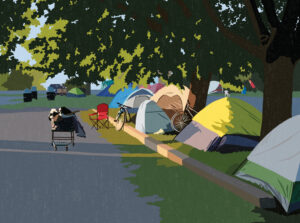
People & Culture
Kahkiihtwaam ee-pee-kiiweehtataahk: Bringing it back home again
The story of how a critically endangered Indigenous language can be saved
- 6310 words
- 26 minutes
This article is over 5 years old and may contain outdated information.
People & Culture

Imagine you have a family of six, and they are all heavy eaters. And when I say heavy eaters, I mean heavy, like 3,000-plus calories a day.
Now imagine that on your next family shopping trip you have to buy food for your family for the next 50 days. That’s three meals a day, two bannocks a day, snacks, dessert and extra meals just in case. In sum, we are talking about over 200 dishes — there are no redos, no emergency trips back to the store and no straying from the plan.
Oh, and did I mention that whatever you buy has to fit into six wannigans with roughly seven cubic feet (one-third of a square metre) of space each and be carried by you and your travel companions?
These are not small tasks — planning, packing, and carrying — and we haven’t even gotten to the cooking yet! Thankfully, once you get to the campsite after a grueling day, gracefully remove your burdensome load and un-tump your wannigan, pretty much anything you make is going to taste like the best meal you have ever eaten.
That being said, true wilderness chefs don’t settle for just any old meal. True wilderness chefs understand that cooking in the bush is a delightful combination of strict planning, taste-driven spontaneity and the unpredictable hair-singeing blast of an open pit wood-powered cooking fire.
You see, most people view wilderness cooking as some sort of undefinable mush that comes out of a plastic bag, or just a jumble of ingredients that require hot water, and voila, a meal in minutes.
Well, let me set the record straight: the members of the Coppermine 2012 expedition will be eating in style. There will often be a frying pan, two pots, and a reflector over all sharing the fire at the same time, producing such delights as fresh catch Pad Thai, Spaghetti alla Puttanesca, beef lasagna and a spicy chicken stir fry. Of course, we will also need some naan bread, dill biscuits, peanut sauce and a peanut butter filled, chocolate frosted dessert bannock to seal the deal.
Yes, we will be eating in style. Like any great expedition, our success will lie in our stomachs.
This trip provides a wonderful opportunity for the wilderness chef, as it will be such a hybrid style of ingredients, preparing and cooking. That is, once we pass above the treeline, we will have to switch from wood-fire to gas, and due to the length of the trip, we will be relying heavily on starches and some delightful freeze-dried accoutrement. On the other hand, the natural freezer that is the Arctic climate will allow us to bring large quantities of perishables such as cured meats, cheeses, garlic and some vegetables along with baking aids like butter. Furthermore, the fishing will be excellent, giving us the option of fish fries or sushi.
So have no fear; this group will be dining like wilderness kings.
Are you passionate about Canadian geography?
You can support Canadian Geographic in 3 ways:

People & Culture
The story of how a critically endangered Indigenous language can be saved

Places
In Banff National Park, Alberta, as in protected areas across the country, managers find it difficult to balance the desire of people to experience wilderness with an imperative to conserve it

People & Culture
The death of an unhoused Innu man inspired an innovative and compassionate street outreach during the nightly curfew in 2021

People & Culture
For unhoused residents and those who help them, the pandemic was another wave in a rising tide of challenges